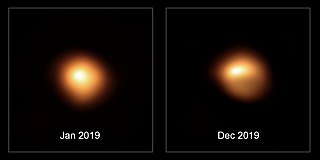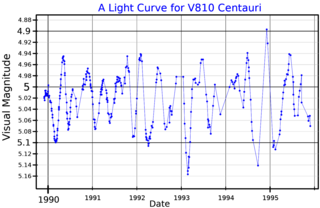
A variable star is a star whose brightness as seen from Earth changes with time. This variation may be caused by a change in emitted light or by something partly blocking the light, so variable stars are classified as either:

In astronomy, a semiregular variable star, a type of variable star, is a giant or supergiant of intermediate and late (cooler) spectral type showing considerable periodicity in its light changes, accompanied or sometimes interrupted by various irregularities. Periods lie in the range from 20 to more than 2000 days, while the shapes of the light curves may be rather different and variable with each cycle. The amplitudes may be from several hundredths to several magnitudes.

Supergiants are among the most massive and most luminous stars. Supergiant stars occupy the top region of the Hertzsprung–Russell diagram with absolute visual magnitudes between about −3 and −8. The temperature range of supergiant stars spans from about 3,400 K to over 20,000 K.

Red supergiants (RSGs) are stars with a supergiant luminosity class of spectral type K or M. They are the largest stars in the universe in terms of volume, although they are not the most massive or luminous. Betelgeuse and Antares A are the brightest and best known red supergiants (RSGs), indeed the only first magnitude red supergiant stars.

A giant star, also simply a giant, is a star with substantially larger radius and luminosity than a main-sequence star of the same surface temperature. They lie above the main sequence on the Hertzsprung–Russell diagram and correspond to luminosity classes II and III. The terms giant and dwarf were coined for stars of quite different luminosity despite similar temperature or spectral type by Ejnar Hertzsprung about 1905.

The descriptive term long-period variable star refers to various groups of cool luminous pulsating variable stars. It is frequently abbreviated to LPV.

Mu Sagittarii is a multiple star system in the constellation of Sagittarius. The brightest component, designated Mu Sagittarii Aa, is formally named Polis. The system is 3,000 light-years from the Sun and is part of the Sgr OB1 stellar association.

RV Tauri is a star in the constellation Taurus. It is a yellow supergiant and is the prototype of a class of pulsating variables known as RV Tauri variables. It is a post-AGB star and a spectroscopic binary about 4,700 light years away.

RV Tauri variables are luminous variable stars that have distinctive light variations with alternating deep and shallow minima.

An Orion variable is a variable star which exhibits irregular and eruptive variations in its luminosity and is typically associated with diffuse nebulae. It is thought that these are young stars which will later become regular, non-variable stars on the zero-age main sequence. Brightness fluctuations can be as much as several magnitudes.

The unqualified term instability strip usually refers to a region of the Hertzsprung–Russell diagram largely occupied by several related classes of pulsating variable stars: Delta Scuti variables, SX Phoenicis variables, and rapidly oscillating Ap stars (roAps) near the main sequence; RR Lyrae variables where it intersects the horizontal branch; and the Cepheid variables where it crosses the supergiants.

W Cephei is a spectroscopic binary and variable star located in the constellation Cepheus. It is thought to be a member of the Cep OB1 stellar association at about 8,000 light years. The supergiant primary star is one of the largest known stars and as well as one of the most luminous red supergiants.

V810 Centauri is a double star consisting of a yellow hypergiant primary and blue giant secondary. It is a small amplitude variable star, entirely due to the supergiant primary which is visually over three magnitudes brighter than the secondary. It is the MK spectral standard for class G0 0-Ia.

A yellow supergiant (YSG) is a star, generally of spectral type F or G, having a supergiant luminosity class. They are stars that have evolved away from the main sequence, expanding and becoming more luminous.

V1401 Aquilae is a single, semi-regular pulsating star in the equatorial constellation of Aquila. It has the designation HD 190390 from the Henry Draper Catalogue, and was formerly designated 64 Sagittarii. The evolutionary status of the star is unclear, and it has been classified as a post-AGB object, a UU Herculis variable, or belonging to the W Virginis variable subclass of the type II Cepheids. It is dimly visible to the naked eye with an apparent visual magnitude that fluctuates around 6.38. Based on parallax measurements, it is located at a distance of approximately 2,380 light years. It lies 21.5° from the galactic plane.

NO Aurigae is a pulsating variable star in the constellation Auriga. It is an unusually-luminous asymptotic giant branch star about 3,500 light years away.
A slow irregular variable is a variable star that exhibit no or very poorly defined periodicity in their slowly changing light emissions. These stars have often been little-studied, and once more is learnt about them, they are reclassified into other categories such as semiregular variables.

RR Telescopii is a symbiotic nova in the southern constellation Telescopium. It was recorded on photographic survey plates as a faint variable star between photographic magnitude (mpg) 9 to 16.6 from 1889 to 1944. In late 1944 the star began to brighten, increasing by about 7 magnitudes, from mpg ≈ 14 to brighter than 8. Brightening continued with a diminished rate of increase after early 1945, but the overall outburst was not noted until the star was seen at about 6.0, the threshold of naked eye brightness, in July 1948. At that time it was given the designation Nova Telescopii 1948. Since mid-1949 it has declined in brightness slowly, albeit accompanied by some remarkable changes in its spectrum, and as of August 2013 it had faded to visual magnitude around 12.

TV Geminorum is a variable red supergiant in the constellation Gemini. Its visual magnitude varies from 6.3 to 7.5.

BO Carinae, also known as HD 93420, is an irregular variable star in the constellation Carina.















